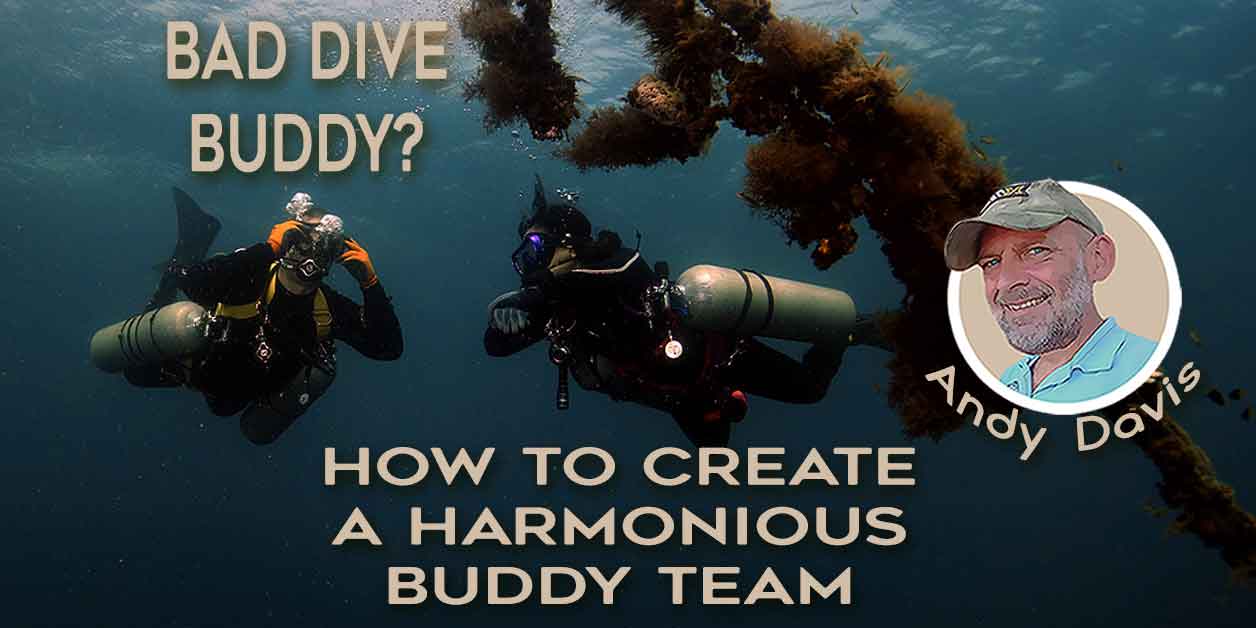A Buddy System Strategy for Air-Sharing Diving Emergencies
Scuba diving is enormous fun, but occasionally things can go wrong. One of those problems is when a diver runs out of gas. That can be caused by negligence or a regulator failure. As a result, scuba divers are trained how to conduct air-sharing ascents.
However, air-sharing in real life is not as straight-forward and easy as it may seem in training. This article describes real-life air sharing and gives advice on how do it more effectively.
Getting “mugged” by an out-of-air diver
I see lots of debate on scuba diving social media about optimal regulator configurations for air-sharing. Divers debate the pros and cons of ‘traditional’ octopus, AIR2 systems, using the long hose, spare air, and pony systems, primary share versus secondary share, options for securing alternate air sources, quick release methods, etc.
Invariably, the issue of “getting mugged” for air is raised. That is, where an out-of-air diver gets panicked by air depletion and ‘mugs’ the donor by, without warning or signal, unexpectedly ripping the regulator out of their mouth. The general consensus is that this should be considered a ‘normal’ or predictable scenario. Some instructors even counsel students to expect this; that is merely normalizing failure.
I disagree. If a diver gets ‘mugged for air’ then it points to a major failing in situational awareness and the buddy system. It should never happen.
Assume stress when air sharing
That doesn’t presume that novice-to-intermediate scuba divers won’t get stressed or panicked by air depletion. It’s wise to assume that inexperienced divers will freak out if their air supply ceases unexpectedly. Stress management to air depletion is not something commonly taught in recreational scuba diving classes anymore.
Whilst ‘dive professionals’ and technical divers receive some training in this respect, the greater majority of scuba divers can only develop calm out-of-air responses with significant time and experience.
Apply the diving buddy system diligently
The diving buddy system is a core principle in nearly all recreational diving training. It is, supposedly, our first line of defense against potentially fatal diving accidents. However, the system needs to be diligently applied if it is to be relied upon.
Sadly, that diligent application is increasingly rare. We live in an age of delegated personal responsibility, where the ‘dive master’ is all too often relied upon to keep us safe, observe and supervise us, and assist with our emergencies. We have a ‘shepherd’, so we’re encouraged to dive like sheep.
The concept of the Open Water diver being qualified to dive “independently and without professional supervision; with a buddy of equal, or higher’ qualification” has ceased to exist in many diving locations around the world. It’s a sad state of affairs and it can lead to tragedy.
Prevent the need for air sharing by proactive behavior
With specific regard to out-of-air emergencies, the diving buddy system should primarily be viewed as a preventative safeguard.
Accident prevention through the diving buddy system can never happen if basic situational awareness is not achieved. Every scuba diver has the capacity to check their own air during a dive. At this time, it is simple to also check/confirm the air of their dive buddy.
Scuba divers can only get ‘gas mugged’ if they are diving in dreamland; switched off and applying zero situational awareness. Getting a regulator ripped from your mouth is definitely a ‘karma occasion’.
Obviously, in an ideal world, the diver will know all about SAC and RMV rates. They will enter the water with an accurate prediction of my air consumption for a given depth and time. Their dive buddy will do likewise. No surprises that way.
But the public increasingly demands quicker, cheaper, and easier dive training courses; so the ‘ideal’ methods get swept aside and deferred to more ‘advanced’ stages of diving education. You get what you pay for.
Gas Management For Scuba Divers

The comprehensive, illustrated, metric guide to advanced gas planning and management for safer scuba diving. Only $9!
60 Pages. Printable PDF format. Fully Illustrated.
Learn gas management skills
For most diving agencies, entry-to-intermediate-level scuba divers aren’t taught how to calculate and monitor SAC/RMV rates. They, therefore, need a different approach; something simple, but effective.
I don’t have gills and I don’t want to drown on a dive, so my finite and exhaustible air supply is a major concern to me when I am diving. That means I routinely check my air over the course of a dive. For an average recreational dive, let’s say 60 minutes, I will probably check it 4 or 5 times. The frequency of checks obviously increases as the dive progresses and my air supply gets lower and more critical. I suggest you endeavor to do the same.
To prevent the chance of an out-of-air emergency within my buddy pair or team, I simply need to inquire what the other divers’ air is whenever I check my own. It’s a case of simple communication that is taught right from the start of Open Water training. I check my air, I check your air. I compare. It’s an easy protocol to remember.
If I know my air level and your air level, then it’s not rocket-science to apply the most simplistic deduction and allow some anticipation of air consumption. I can easily identify the relative air consumption between myself and another diver.
For example, when you check air over the course of a dive;
- You have 180 bar, your buddy has 170 bar.
- You have 140 bar, your buddy has 120 bar.
- You have 110 bar, your buddy has 90 bar.
- You have 90 bar, your buddy is likely to have __ bar?
You can quickly work out if your dive buddy’s air consumption is higher, or lower than yours. Furthermore, over several checks, you can see a pattern that gives a very loose approximation of how much difference there is between your air consumption. This allows the most basic predictions to be made. Those predictions are sufficient to prevent most diving out-of-air emergencies.
In the example above, you can anticipate that when you reach 90 bar, your dive buddy should now be very close to their reserve air level (50 bar). You will know the dive is nearly over. It is time for you to start paying close attention to your dive buddy, confirm their air, and start your ascent.
Predicting gas consumption = less air-sharing emergencies
In the space of the dive, you can predict that when you reach 90 bar of air remaining, your buddy is likely to be at, or close to, their own air reserve level. That becomes your warning trigger. Once reached, you have to do something about it.

Having anticipated that your buddy is probably getting low on air, you should raise your level of buddy observation and focus. You should get closer to them and should quickly confirm that your alternate air source (of whatever configuration) is available, working, and ready to deploy.
The worst-case scenario is that, even with anticipation, your buddy might still run out of air. That can happen for several reasons; such as some SPGs not reading accurately below 50 bar / 500psi, a poorly performing regulator that can’t deliver at lower intermediate pressures, or an unanticipated ‘spike’ in breathing rates.
If you are pro-actively observing, then you will immediately notice any symptoms of air depletion stress in your buddy; shortened breathing, wide eyes, rapid head, and arm movements, the desperate grab for an SPG; and your alternate air source will be rapidly deployed and waiting a couple of inches from their mouth. Salvation is immediately on hand, and a panicked diver scenario is avoided. The air-sharing ascent should be calm, methodical, and satisfying; just like it was when you practiced it in training.
The best case scenario, of course, is that you can identify a low-on-air situation and proactively offer to share air before an out-of-air emergency even occurs. Personally, I’d rather donate air whilst my dive buddy still has a little air remaining. Anything less than 35 bar in your cylinder and I will physically offer my alternate air source for the ascent. Take it or leave it, but prevention is better than cure.
If air-sharing surprises you, don’t blame the victim
No exceptions, and no excuses. If another diver reaches a stage where they are panicking from unanticipated air depletion; and feels the urge to ‘mug’ me of my primary regulator, then it is equally MY failure as their buddy or teammate.
The buddy system relies on three critical attributes:
- observation
- awareness
- anticipation
Especially in regard to air-sharing. If you allow weak situational awareness to impede the buddy system then there can be negative consequences. Divers have died because of unanticipated, botched air-sharing attempts.
Anticipating the need for air-sharing stops a mistake from becoming an emergency and then turning into a catastrophe. The difference is all about avoiding diver stress and panic.
There’s something very reassuring; and stress nullifying, to know that your buddy ‘has your back’ and is ready and able to give you life-sustaining air without notice or delay.
About The Author

Andy Davis is a RAID, PADI TecRec, ANDI, BSAC, and SSI-qualified independent technical diving instructor who specializes in teaching sidemount, trimix, and advanced wreck diving courses.
Currently residing in Subic Bay, Philippines; he has amassed more than 10,000 open-circuit and CCR dives over three decades of challenging diving across the globe.
Andy has published numerous diving magazine articles and designed advanced certification courses for several dive training agencies, He regularly tests and reviews new dive gear for scuba equipment manufacturers. Andy is currently writing a series of advanced diving books and creating a range of tech diving clothing and accessories.
Prior to becoming a professional technical diving educator in 2006, Andy was a commissioned officer in the Royal Air Force and has served in Iraq, Afghanistan, Belize, and Cyprus.
In 2023, Andy was named in the “Who’s Who of Sidemount” list by GUE InDepth Magazine.
Purchase my exclusive diving ebooks!
Originally posted 2018-11-05 06:10:51.














